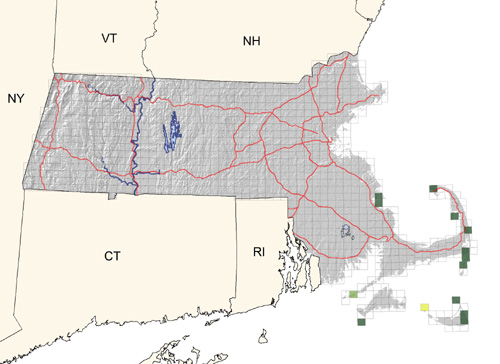Breeding Bird Atlases (BBA)
Find a Bird - BBA1
Breeding Bird Atlas 1 Species Accounts
Arctic Tern
Sterna paradisaea
State Status
Special Concern
Egg Dates
May 23 to July 27
Number of Broods
one

A widespread arctic and subarctic species, the Arctic Tern reaches its extreme southern limit on the coast of Massachusetts, where it is now confined to half a dozen breeding sites on outer beaches from Plymouth Beach, and around Cape Cod, to Nomans Land. It is rarely seen except at the breeding colonies. It has probably never been abundant in the state, but it prospered under protection in the early years of this century and reached a peak of 300 to 400 pairs in the 1940s. Since then it has steadily decreased: only 18 pairs were found in 1985, and it appears headed for extirpation.
Arctic Terns arrive at the breeding colonies in mid- to late May. They commonly catch small schooling fish in open water and are sometimes found farther from land than other terns. However, they also catch fish and invertebrates in shallow water close to shore and may pick up sandworms or other invertebrates from the surface of tidal flats. They prefer to nest on open sandy or gravelly places, usually on the outer edge of colonies of Common Terns but sometimes within colonies of Least Terns.
Arctic Terns are most readily distinguished from Common Terns in mixed colonies by the timbre of their voices. The commonest alarm calls are a descending ki-yerrr and a trilling krrree; both are higher pitched and have a more squealing quality than those of Common Terns. Birds carrying fish give a high-pitched polysyllabic call, kittiweewit, kittiweewit. The aerial display flight is similar to that of Common Terns, although Arctic Terns also have a low-altitude flight display in which two or three birds fly through the colony with wings raised in a V over their back. Arctic Terns are lighter on the wing than Common Terns, and they are more prone to hover, both when feeding and when disturbed by intruders near the nest. They can often be seen resting on the sand near the breeding colonies, where their short legs readily distinguish them from accompanying Common Terns.
Arctic Terns usually lay one or two eggs in a scrape on open sand. Most eggs are laid in a short period between May 28 and June 15. Although a few young birds lay in late June or early July, Arctic Terns do not regularly renest if they lose eggs or young. During incubation, scraps of vegetation or shell are added to the nest, but Arctic Terns rarely build nests as substantial as those of Common Terns. After hatching, the chicks are usually moved away from the open nest site to areas with more cover, sometimes outside the area where other terns are nesting. Both sexes share in the 21- to 23-day incubation period and in feeding the young. Arctic Terns vigorously defend their nests and young against humans and other predators. They dive silently on human intruders from behind, pecking them sharply on the head and uttering an angry kyaaa as they swoop upward. Despite these active defense measures, the Arctic Terns’ habit of nesting on the outer edge of tern colonies, often on sites attached to the mainland, makes them particularly vulnerable to predation and to human disturbance and vandalism. Their preference for low-lying nest sites also makes them vulnerable to flooding during high tides. For these reasons, their breeding success has been very low in Massachusetts in recent decades, and they have failed to benefit greatly from protective measures that have been effective for the other tern species. The average fledging success in Massachusetts from the late 1960s to the early 1980s was .2 young per pair.
Family groups leave the breeding colonies almost as soon as the young can fly, at 23 to 28 days of age, and Arctic Terns are rarely seen in Massachusetts after August 7. Their initial movement on departure is probably toward the northeast, and their autumn migration takes them directly across the Atlantic Ocean to southwestern Europe or western Africa. They then migrate down the African coast toward their winter quarters in the Antarctic. In contrast with other tern species, one-year-old Arctic Terns migrate north only slightly later than the adults and can be seen around the breeding colonies in June and July. These one-year- old birds have a distinctive plumage with a white forehead and underparts, and a black nape, bill, legs, and carpal bar. They were once described as a separate species, “Sterna portlandica,” and are still known by that name. They are sometimes present at Monomoy and Nauset in flocks of 100 to 500 birds, far exceeding the local breeding population. Arctic Terns do not breed, however, until they are three or four years old. If they survive to this age, they have an unusually high life expectancy; a number of birds banded in Massachusetts have been found breeding when they were 15 to 20 years old, and one even at age 27.
The Arctic Tern is listed as a species of special concern in Massachusetts.
Map Legend and Data Summary
Atlas 1 data collected from 1975-1979


Note: very uncommon and local, steadily declining
Ian C. T. Nisbet



